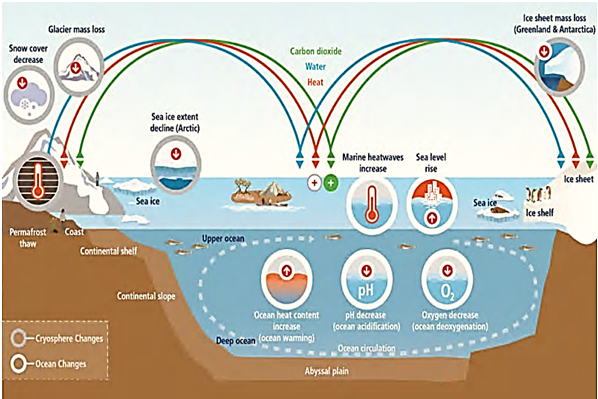IPCC Special Report On The Ocean And Cryosphere
- 26 Sep 2019
- On 25th September, 2019, the Intergovernmental Panel on Climate Change (IPCC) released a report under the name- ‘Special Report on the Ocean and Cryosphere in a Changing Climate(SROCC)’ which highlights the adverse changes taking place in oceans, glaciers and ice-deposits on land and sea due to the climate change.
- The was prepared following an IPCC Panel decision in 2016 to prepare three Special Reports and follows the Special Reports on Global Warming of 1.5°C (SR1.5) released in October 2018, and on Climate Change and Land (SRCCL), released in August, 2019.
Major Findings of the Report
- Sea level Rising:Global mean sea-level had increased by 16 cm between 1902 and 2015, and that the rate of increase had doubled of late. Between 2006 and 2015, global mean sea level recorded an average rise of 3.6 mm per year, which was more than double of 1.4 mm per year recorded in the first 90-year-period of the 20th century.
- Shrinking Cryosphere:Over the last decades, global warming has led to widespread shrinking of the cryosphere, with mass loss from ice sheets and glaciers, reductions in snow cover and Arctic sea ice extent and thickness.Mass loss from the Antarctic ice sheet over the period 2007– 2016 tripled relative to 1997–2006.
- Increasing Ocean and Marine Heat:Global ocean has warmed unabated since 1970 and has taken up more than 90% of the excess heat in the climate system.Since 1993, the rate of ocean warming has more than doubled. Also, the marine heat waves have doubled in frequency since 1982 and are increasing in intensity.
- Ocean Acidification:The Ocean has taken up between 20–30% of total anthropogenic CO2 emissions since the 1980s causing the acidification of oceans.
- Ocean Deoxygenation: A loss of oxygen has occurred from the surface to 1000 m due to climate change.
Intergovernmental Panel on Climate Change (IPCC)
|
Impact
- Food and water security have been negatively impacted by changes in snow cover, lake and river ice, and permafrost in many Arctic regions.
- Glacier retreat and snow cover changes have contributed to localized declines in agricultural yields in high mountain regions, including Hindu Kush Himalaya and the tropical Andes.
- Negative impacts of cryosphere change on human health have included increased risk of food- and waterborne diseases, malnutrition and mental health challenges especially among Indigenous peoples.
- Increasing ocean acidification and oxygen loss are negatively impacting two major upwelling systems: the California Current and Humboldt Current.
- Decrease in oxygen level hasaltered ecosystem structure, with direct negative impacts on biomass production and species composition.
- Ocean warming has contributed to an overall decrease in maximum catch potential, impacting the fishery sector round the world.
- Marine heatwaves have already resulted in large-scale coral bleaching eventscausing worldwide reef degradation.
- Coastal communities are exposed to multiple climate-related hazards, including tropical cyclones, extreme sea levels and flooding, marine heat waves, sea ice loss, and permafrost thawing.
Role of Ocean and Cryosphere in Earth System
Source: IPCC |
Significance of the Report
- It provides new evidence for the benefits of limiting global warming to the lowest possible level – in line with the goal that governments set themselves in the 2015 Paris Agreement.
- SROCC provides the best available scientific knowledge to empower governments and communities to take action, embedding that scientific knowledge on unavoidable change and plausible futures into their own context, to limit the scale of risks and climate impacts.
- It is a key scientific input for world leaders gathering in forthcoming climate and environment negotiations, such as the UN Framework Convention on Climate Change Conference (COP25) in Chile in December, 2019.
Way Forward
- Over the 21st century, the ocean is projected to transition to unprecedented conditions with increased temperatures, greater upper ocean stratification, further acidification, oxygen decline and altered net primary production.
- Extreme El Nino and La Nina events are projected to likely increase in frequency in the 21st century with intensified drier or wetter responses in several regions across the globe.
- Integrated water managementand ecosystem-based adaptationapproaches lower climate risks locally and provide multiple societal benefits.
- Networks of protected areas help maintain ecosystem services, including carbon uptake and storage, and enable future ecosystem-based adaptations.
- Restoration of vegetated coastal ecosystems, such as mangroves, tidal marshes could provide climate change mitigation through increased carbon uptake.
- Ocean renewable energy can support climate change mitigation, and can comprise energy extraction from offshore winds, tides, waves, thermal and salinity gradient and algal biofuels.
- Education and climate literacy, monitoring and forecasting, use of all available knowledge sources, sharing of data, information and knowledge, finance, addressing social vulnerability and equity, and institutional support are essential in mitigating climate change.
- Utilization of multiple knowledge systems and regional climate information into decision making, and the engagement of local communities, Indigenous peoples, and relevant stakeholders will help in reducing the climate related changes.
- Intensifying cooperation and coordination among governing authorities across scales, jurisdictions, sectors, policy domains and planning horizons can enable effective responses to changes in the ocean, cryosphere and to sea level rise.
- Regional cooperation, including treaties and conventions can support adaptation actions, mitigating the effect of climate change.
- The United Nations 2030 Sustainable Development Goals (SDGs) are all connected to varying extents with the ocean and cryosphere. Climate action (SDG13) would help limit the future ocean and cryosphere changes and reduce the associated risks including life below water, and clean water and sanitation.Limiting greenhouse gas emissions opens more options for effective adaptation leading towards the sustainable development.



